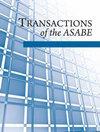Non-Destructive Evaluation of Salmon and Tuna Freshness in a Room-Temperature Incubation Environment Using a Portable Visible/Near-Infrared Imaging Spectrometer
IF 1.4
4区 农林科学
Q3 AGRICULTURAL ENGINEERING
引用次数: 1
Abstract
HighlightsWhile freshness is a critical value of food quality, its assessment requires complex methods, which are costly and time-consuming.In this work, it is demonstrated that spectral responses obtained from a portable VIS/NIR imaging spectrometer can be used to predict food freshness using a CNN-based machine learning algorithm.In the food industry, the method can assess real-time food freshness nondestructively and cost-effectively.Abstract. There has been strong demand for the development of accurate but simple methods to assess the freshness of foods. In this study, a system is proposed to determine the freshness of fish by analyzing the spectral response with a portable visible/near-infrared (VIS/NIR) imaging spectrometer and a convolution neural network (CNN) machine learning algorithm. Spectral response data from salmon and tuna, which were incubated at 25°C, were obtained every minute for 30 h and were categorized into three stages (fresh, likely spoiled, or spoiled) based on the time and pH. Using the obtained spectral data, a CNN-based machine learning algorithm was built to evaluate the freshness of the experimental samples. The accuracy of the spectral data in predicting the freshness was ~84% for salmon and ~88% for tuna. Keywords: CNN, Fish, Freshness, pH, Spectral data, VIS/NIR.使用便携式可见/近红外成像光谱仪无损评价室温培养环境下鲑鱼和金枪鱼的新鲜度
虽然新鲜度是食品质量的一个关键价值,但它的评估需要复杂的方法,既昂贵又耗时。在这项工作中,证明了从便携式VIS/NIR成像光谱仪获得的光谱响应可以使用基于cnn的机器学习算法来预测食物新鲜度。在食品工业中,该方法可以无损且经济有效地实时评估食品新鲜度。人们强烈要求开发准确而简单的方法来评估食品的新鲜度。在本研究中,提出了一种利用便携式可见/近红外(VIS/NIR)成像光谱仪和卷积神经网络(CNN)机器学习算法分析光谱响应来确定鱼类新鲜度的系统。在25°C下孵卵30 h,每分钟获得鲑鱼和金枪鱼的光谱响应数据,并根据时间和ph将其分为新鲜、可能变质或变质三个阶段。利用获得的光谱数据,构建基于cnn的机器学习算法来评估实验样品的新鲜度。光谱数据对鲑鱼和金枪鱼新鲜度的预测准确率分别为~84%和~88%。关键词:CNN,鱼,新鲜度,pH值,光谱数据,VIS/NIR。
本文章由计算机程序翻译,如有差异,请以英文原文为准。
求助全文
约1分钟内获得全文
求助全文
来源期刊

Transactions of the ASABE
AGRICULTURAL ENGINEERING-
CiteScore
2.30
自引率
0.00%
发文量
0
审稿时长
6 months
期刊介绍:
This peer-reviewed journal publishes research that advances the engineering of agricultural, food, and biological systems. Submissions must include original data, analysis or design, or synthesis of existing information; research information for the improvement of education, design, construction, or manufacturing practice; or significant and convincing evidence that confirms and strengthens the findings of others or that revises ideas or challenges accepted theory.
 求助内容:
求助内容: 应助结果提醒方式:
应助结果提醒方式:


